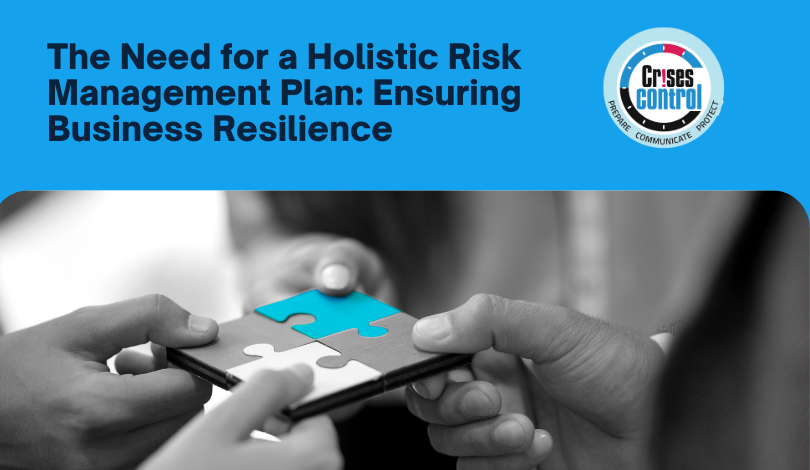In today’s rapidly changing business landscape, the need for effective risk management has become paramount. Organisations face numerous risks that can significantly impact their operations, reputation, and bottom line. To navigate these challenges successfully, businesses require a holistic risk management plan that encompasses all aspects of potential threats and vulnerabilities. In this blog, we will delve into the importance of adopting a holistic approach to risk management and how it can benefit organisations. Additionally, we will explore the common gaps in traditional risk management approaches, the essential tools needed for a complete risk management plan.
Why You Need a Holistic Approach
Identifying and Assessing Risks
A holistic risk management approach allows businesses to identify and assess risks comprehensively. Instead of solely focusing on financial risks or specific operational areas, a holistic approach considers a wide range of potential threats. By conducting a thorough analysis of internal and external factors, organisations can proactively identify risks that might otherwise go unnoticed. This approach helps in developing effective risk mitigation strategies and contingency plans.
Understanding Interdependencies
Businesses operate in complex ecosystems with interdependencies between various processes, departments, and stakeholders. A holistic risk management plan takes into account these interdependencies and examines how disruptions in one area can cascade and affect the entire organisation. By understanding these relationships, businesses can develop more robust risk mitigation strategies and build resilience throughout the organisation.
Emphasising Proactive Measures
Traditional risk management often focuses on reactive measures to address crises as they occur. However, a holistic approach emphasises proactive measures to prevent risks from materialising or escalating. By identifying early warning signs, conducting risk assessments, and implementing proactive measures, organisations can minimise the impact of potential risks and protect their operations.
Enhancing Decision-Making Processes
A holistic risk management plan provides organisations with a comprehensive view of potential risks. This enables informed decision-making processes that consider the potential impact of risks on various aspects of the business. By integrating risk management into strategic decision-making, organisations can make more confident choices that align with their overall objectives while minimising potential threats.
What Most Businesses Miss
Despite recognising the importance of risk management, many businesses often overlook crucial elements that can leave them vulnerable to unforeseen events. Here are some aspects that are frequently missed in traditional risk management approaches:
Lack of Communication and Coordination
Inadequate communication and coordination across departments can hinder effective risk management. Siloed information and fragmented processes make it challenging to identify and address risks comprehensively. A holistic approach emphasises cross-functional collaboration, ensuring that risk management strategies are shared, understood, and implemented consistently throughout the organisation.
Ignoring Emerging Risks
Business environments are dynamic, and new risks continually emerge. organisations that fail to regularly reassess their risk landscape may overlook emerging risks that could have a significant impact on their operations. A holistic risk management plan incorporates mechanisms to continually monitor and evaluate the evolving risk landscape, allowing businesses to stay ahead of potential threats.
Neglecting Human Factors
While technological advancements play a crucial role in risk management, organisations must not overlook the importance of human factors. Employee training, awareness, and engagement are vital components of an effective risk management plan. A holistic approach recognises the significance of people in managing risks and ensures that adequate attention is given to training, communication, and fostering a risk-aware culture.
Tools You Need to Have in Place
To establish a comprehensive risk management plan, organisations need to have the right tools and technologies in place. These tools assist in identifying, assessing, and monitoring risks efficiently. Here are some essential tools that should be part of a complete risk management plan:
Risk Assessment Software
Effective risk assessment is crucial for understanding the likelihood and impact of various risks. Risk assessment software provides a structured framework for evaluating risks, capturing data, and generating insightful reports. These tools enable organisations to prioritise risks based on their potential consequences and allocate resources accordingly.
Incident Management System
An incident management system is essential for handling and responding to incidents and crises swiftly and effectively. It facilitates real-time communication, collaboration, and coordination among key stakeholders during a crisis. With features like incident tracking, automated notifications, and documentation capabilities, an incident management system ensures a streamlined response to mitigate the impact of risks.
Business Continuity Planning Tools
Business continuity planning tools assist organisations in developing and maintaining robust continuity plans. These tools enable businesses to document critical processes, establish recovery strategies, and create comprehensive response plans. With features like plan testing, version control, and plan activation workflows, these tools ensure that organisations are well-prepared to manage disruptions and minimise downtime.
Communication and Notification Systems
During a crisis or risk event, effective communication is vital. Communication and notification systems provide organisations with the ability to rapidly disseminate information, instructions, and updates to employees, stakeholders, and customers. These systems offer multi-channel communication capabilities, ensuring that critical messages reach the intended recipients promptly.
Data Analytics and Monitoring Tools
Data analytics and monitoring tools enable organisations to detect patterns, trends, and anomalies that may indicate emerging risks or vulnerabilities. By analysing data from various sources, such as financial records, operational metrics, and external factors, these tools provide valuable insights into potential risks. This information helps organisations make data-driven decisions and implement proactive risk mitigation strategies.
Benefits of a Holistic Risk Management Plan
A holistic risk management plan brings numerous benefits to organisations, beyond simply addressing crises and mitigating risks. Here are some key advantages that businesses can derive from adopting a comprehensive approach:
Enhanced Resilience
By considering a wide range of risks and interdependencies, a holistic risk management plan builds resilience throughout the organisation. It enables businesses to anticipate and respond to potential disruptions effectively, minimising their impact on operations, reputation, and financial stability. This resilience allows organisations to adapt to changing circumstances and maintain continuity even in the face of adversity.
Improved Stakeholder Confidence
A robust risk management plan demonstrates an organisation’s commitment to mitigating potential threats and protecting its stakeholders. Whether it’s employees, customers, investors, or regulatory bodies, stakeholders gain confidence in the organisation’s ability to navigate risks effectively. This increased confidence can lead to stronger relationships, improved reputation, and a competitive advantage in the market.
Cost Savings
Proactive risk management helps organisations avoid or minimise the financial consequences associated with risks. By identifying and addressing potential risks early on, businesses can reduce the likelihood of costly incidents and crises. This proactive approach also enables organisations to optimise resource allocation, ensuring that investments are aligned with the most significant risks and areas of vulnerability.
Regulatory Compliance
Many industries have stringent regulatory requirements related to risk management. A holistic risk management plan helps organisations meet these compliance obligations effectively. By integrating regulatory requirements into their risk management practices, businesses can demonstrate adherence to standards, minimise penalties, and ensure a more secure operating environment.
Conclusion
Implementing a holistic risk management plan brings numerous benefits to organisations. It enhances resilience, in stills stakeholder confidence, generates cost savings, ensures regulatory compliance, and promotes continuous improvement. By integrating risk management into their organisational DNA, businesses can navigate uncertainties with greater confidence, protect their operations and reputation, and seize opportunities for growth.
In this context, Crises Control emerges as a comprehensive solution for organisations seeking to implement a holistic risk management plan. With its suite of features and capabilities, Crises Control empowers businesses to respond to risks effectively. From incident management tools to business continuity planning and communication systems, Crises Control provides the tools necessary for a complete risk management framework.
With Crises Control, organisations can streamline their risk management processes, enhance their resilience, and build a risk-aware culture. By leveraging its capabilities, businesses can proactively address potential threats, minimise the impact of crises, and ensure the continuity of their operations. To build organisational resilience get in touch with our experts today!








